Shiwei Liu
Demystifying the Roles of LLM Layers in Retrieval, Knowledge, and Reasoning
Oct 02, 2025Abstract:Recent studies suggest that the deeper layers of Large Language Models (LLMs) contribute little to representation learning and can often be removed without significant performance loss. However, such claims are typically drawn from narrow evaluations and may overlook important aspects of model behavior. In this work, we present a systematic study of depth utilization across diverse dimensions, including evaluation protocols, task categories, and model architectures. Our analysis confirms that very deep layers are generally less effective than earlier ones, but their contributions vary substantially with the evaluation setting. Under likelihood-based metrics without generation, pruning most layers preserves performance, with only the initial few being critical. By contrast, generation-based evaluation uncovers indispensable roles for middle and deeper layers in enabling reasoning and maintaining long-range coherence. We further find that knowledge and retrieval are concentrated in shallow components, whereas reasoning accuracy relies heavily on deeper layers -- yet can be reshaped through distillation. These results highlight that depth usage in LLMs is highly heterogeneous and context-dependent, underscoring the need for task-, metric-, and model-aware perspectives in both interpreting and compressing large models.
Diffusion Language Models Know the Answer Before Decoding
Aug 27, 2025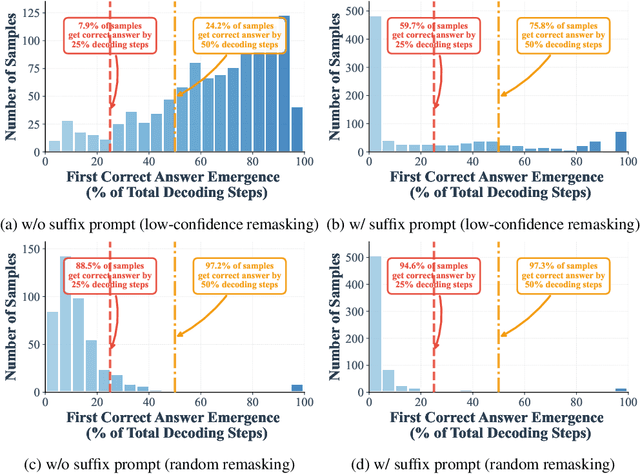
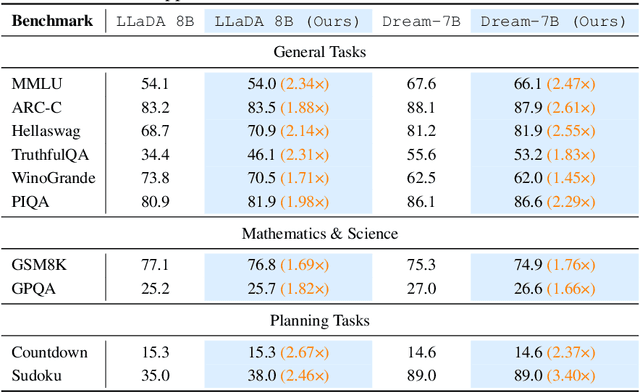
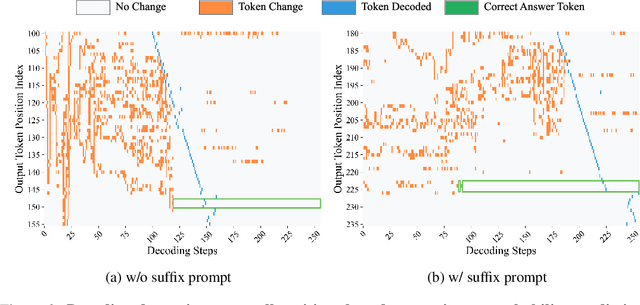
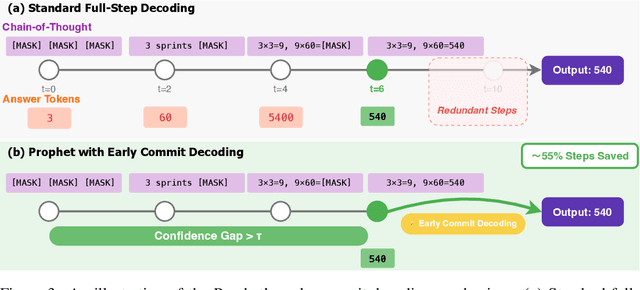
Abstract:Diffusion language models (DLMs) have recently emerged as an alternative to autoregressive approaches, offering parallel sequence generation and flexible token orders. However, their inference remains slower than that of autoregressive models, primarily due to the cost of bidirectional attention and the large number of refinement steps required for high quality outputs. In this work, we highlight and leverage an overlooked property of DLMs early answer convergence: in many cases, the correct answer can be internally identified by half steps before the final decoding step, both under semi-autoregressive and random remasking schedules. For example, on GSM8K and MMLU, up to 97% and 99% of instances, respectively, can be decoded correctly using only half of the refinement steps. Building on this observation, we introduce Prophet, a training-free fast decoding paradigm that enables early commit decoding. Specifically, Prophet dynamically decides whether to continue refinement or to go "all-in" (i.e., decode all remaining tokens in one step), using the confidence gap between the top-2 prediction candidates as the criterion. It integrates seamlessly into existing DLM implementations, incurs negligible overhead, and requires no additional training. Empirical evaluations of LLaDA-8B and Dream-7B across multiple tasks show that Prophet reduces the number of decoding steps by up to 3.4x while preserving high generation quality. These results recast DLM decoding as a problem of when to stop sampling, and demonstrate that early decode convergence provides a simple yet powerful mechanism for accelerating DLM inference, complementary to existing speedup techniques. Our code is publicly available at https://github.com/pixeli99/Prophet.
AlphaDecay:Module-wise Weight Decay for Heavy-Tailed Balancing in LLMs
Jun 17, 2025Abstract:Weight decay is a standard regularization technique for training large language models (LLMs). While it is common to assign a uniform decay rate to every layer, this approach overlooks the structural diversity of LLMs and the varying spectral properties across modules. In this paper, we introduce AlphaDecay, a simple yet effective method that adaptively assigns different weight decay strengths to each module of an LLM. Our approach is guided by Heavy-Tailed Self-Regularization (HT-SR) theory, which analyzes the empirical spectral density (ESD) of weight correlation matrices to quantify "heavy-tailedness." Modules exhibiting more pronounced heavy-tailed ESDs, reflecting stronger feature learning, are assigned weaker decay, while modules with lighter-tailed spectra receive stronger decay. Our method leverages tailored weight decay assignments to balance the module-wise differences in spectral properties, leading to improved performance. Extensive pre-training tasks with various model sizes from 60M to 1B demonstrate that AlphaDecay achieves better perplexity and generalization than conventional uniform decay and other adaptive decay baselines.
A Technical Study into Small Reasoning Language Models
Jun 16, 2025Abstract:The ongoing evolution of language models has led to the development of large-scale architectures that demonstrate exceptional performance across a wide range of tasks. However, these models come with significant computational and energy demands, as well as potential privacy implications. In this context, Small Reasoning Language Models (SRLMs) with approximately 0.5 billion parameters present a compelling alternative due to their remarkable computational efficiency and cost effectiveness, particularly in resource-constrained environments. Despite these advantages, the limited capacity of 0.5 billion parameter models poses challenges in handling complex tasks such as mathematical reasoning and code generation. This research investigates various training strategies, including supervised fine-tuning (SFT), knowledge distillation (KD), and reinforcement learning (RL), as well as their hybrid implementations, to enhance the performance of 0.5B SRLMs. We analyze effective methodologies to bridge the performance gap between SRLMS and larger models and present insights into optimal training pipelines tailored for these smaller architectures. Through extensive experimental validation and analysis, our work aims to provide actionable recommendations for maximizing the reasoning capabilities of 0.5B models.
Leave it to the Specialist: Repair Sparse LLMs with Sparse Fine-Tuning via Sparsity Evolution
May 29, 2025

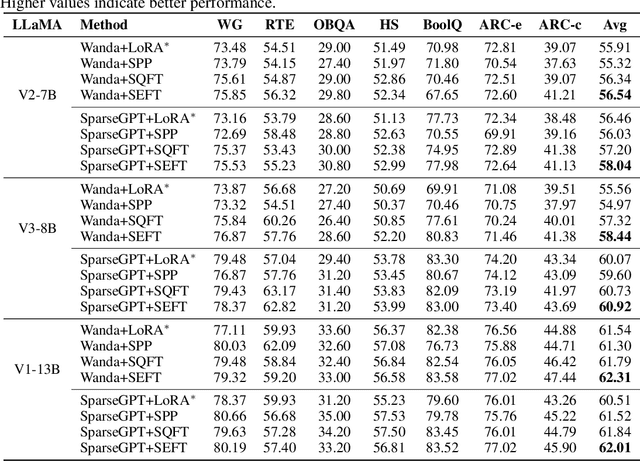
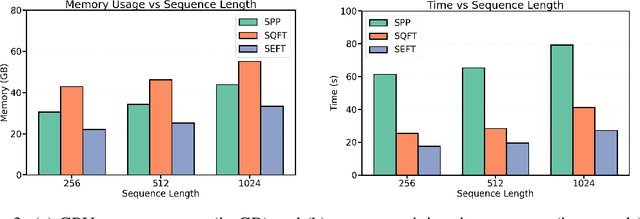
Abstract:Large language models (LLMs) have achieved remarkable success across various tasks but face deployment challenges due to their massive computational demands. While post-training pruning methods like SparseGPT and Wanda can effectively reduce the model size, but struggle to maintain model performance at high sparsity levels, limiting their utility for downstream tasks. Existing fine-tuning methods, such as full fine-tuning and LoRA, fail to preserve sparsity as they require updating the whole dense metrics, not well-suited for sparse LLMs. In this paper, we propose Sparsity Evolution Fine-Tuning (SEFT), a novel method designed specifically for sparse LLMs. SEFT dynamically evolves the sparse topology of pruned models during fine-tuning, while preserving the overall sparsity throughout the process. The strengths of SEFT lie in its ability to perform task-specific adaptation through a weight drop-and-grow strategy, enabling the pruned model to self-adapt its sparse connectivity pattern based on the target dataset. Furthermore, a sensitivity-driven pruning criterion is employed to ensure that the desired sparsity level is consistently maintained throughout fine-tuning. Our experiments on various LLMs, including LLaMA families, DeepSeek, and Mistral, across a diverse set of benchmarks demonstrate that SEFT achieves stronger performance while offering superior memory and time efficiency compared to existing baselines. Our code is publicly available at: https://github.com/QiaoXiao7282/SEFT.
NeuroTrails: Training with Dynamic Sparse Heads as the Key to Effective Ensembling
May 23, 2025Abstract:Model ensembles have long been a cornerstone for improving generalization and robustness in deep learning. However, their effectiveness often comes at the cost of substantial computational overhead. To address this issue, state-of-the-art methods aim to replicate ensemble-class performance without requiring multiple independently trained networks. Unfortunately, these algorithms often still demand considerable compute at inference. In response to these limitations, we introduce $\textbf{NeuroTrails}$, a sparse multi-head architecture with dynamically evolving topology. This unexplored model-agnostic training paradigm improves ensemble performance while reducing the required resources. We analyze the underlying reason for its effectiveness and observe that the various neural trails induced by dynamic sparsity attain a $\textit{Goldilocks zone}$ of prediction diversity. NeuroTrails displays efficacy with convolutional and transformer-based architectures on computer vision and language tasks. Experiments on ResNet-50/ImageNet, LLaMA-350M/C4, among many others, demonstrate increased accuracy and stronger robustness in zero-shot generalization, while requiring significantly fewer parameters.
SoS1: O1 and R1-Like Reasoning LLMs are Sum-of-Square Solvers
Feb 27, 2025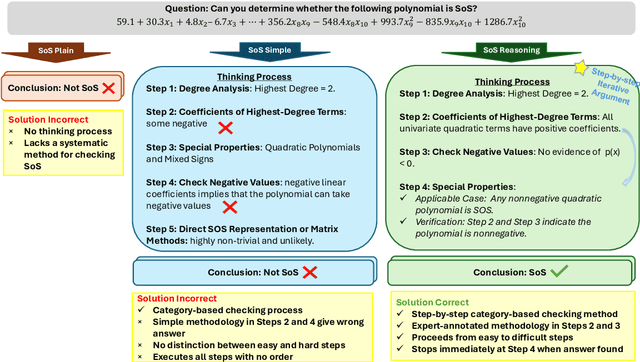
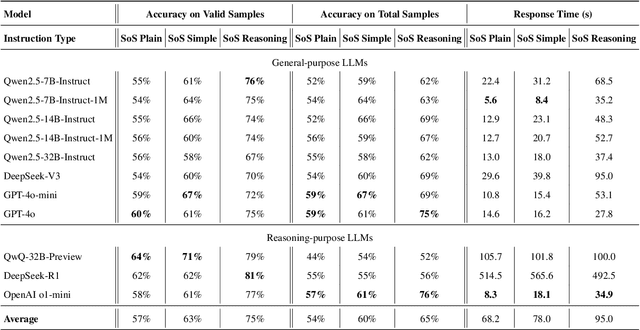
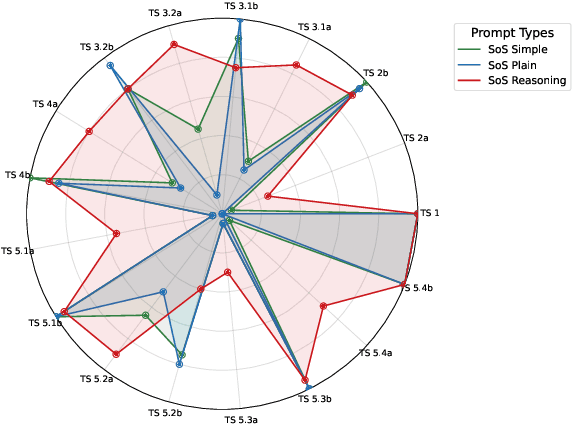
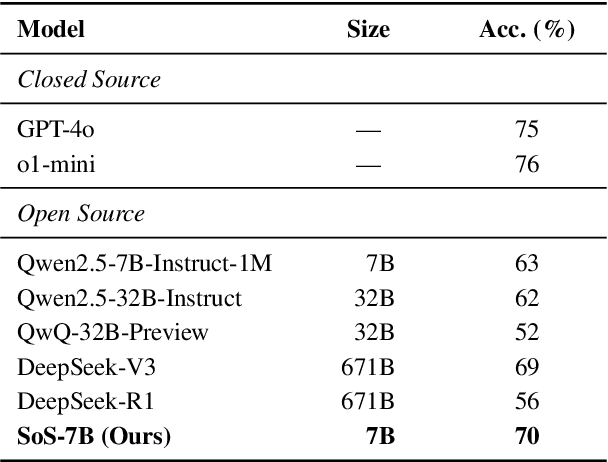
Abstract:Large Language Models (LLMs) have achieved human-level proficiency across diverse tasks, but their ability to perform rigorous mathematical problem solving remains an open challenge. In this work, we investigate a fundamental yet computationally intractable problem: determining whether a given multivariate polynomial is nonnegative. This problem, closely related to Hilbert's Seventeenth Problem, plays a crucial role in global polynomial optimization and has applications in various fields. First, we introduce SoS-1K, a meticulously curated dataset of approximately 1,000 polynomials, along with expert-designed reasoning instructions based on five progressively challenging criteria. Evaluating multiple state-of-the-art LLMs, we find that without structured guidance, all models perform only slightly above the random guess baseline 50%. However, high-quality reasoning instructions significantly improve accuracy, boosting performance up to 81%. Furthermore, our 7B model, SoS-7B, fine-tuned on SoS-1K for just 4 hours, outperforms the 671B DeepSeek-V3 and GPT-4o-mini in accuracy while only requiring 1.8% and 5% of the computation time needed for letters, respectively. Our findings highlight the potential of LLMs to push the boundaries of mathematical reasoning and tackle NP-hard problems.
Stable-SPAM: How to Train in 4-Bit More Stably than 16-Bit Adam
Feb 24, 2025



Abstract:This paper comprehensively evaluates several recently proposed optimizers for 4-bit training, revealing that low-bit precision amplifies sensitivity to learning rates and often causes unstable gradient norms, leading to divergence at higher learning rates. Among these, SPAM, a recent optimizer featuring momentum reset and spike-aware gradient clipping, achieves the best performance across various bit levels, but struggles to stabilize gradient norms, requiring careful learning rate tuning. To address these limitations, we propose Stable-SPAM, which incorporates enhanced gradient normalization and clipping techniques. In particular, Stable-SPAM (1) adaptively updates the clipping threshold for spiked gradients by tracking their historical maxima; (2) normalizes the entire gradient matrix based on its historical $l_2$-norm statistics; and $(3)$ inherits momentum reset from SPAM to periodically reset the first and second moments of Adam, mitigating the accumulation of spiked gradients. Extensive experiments show that Stable-SPAM effectively stabilizes gradient norms in 4-bit LLM training, delivering superior performance compared to Adam and SPAM. Notably, our 4-bit LLaMA-1B model trained with Stable-SPAM outperforms the BF16 LLaMA-1B trained with Adam by up to $2$ perplexity. Furthermore, when both models are trained in 4-bit, Stable-SPAM achieves the same loss as Adam while requiring only about half the training steps. Code is available at https://github.com/TianjinYellow/StableSPAM.git.
Mask-Enhanced Autoregressive Prediction: Pay Less Attention to Learn More
Feb 11, 2025



Abstract:Large Language Models (LLMs) are discovered to suffer from accurately retrieving key information. To address this, we propose Mask-Enhanced Autoregressive Prediction (MEAP), a simple yet effective training paradigm that seamlessly integrates Masked Language Modeling (MLM) into Next-Token Prediction (NTP) to enhance the latter's in-context retrieval capabilities. Specifically, MEAP first randomly masks a small fraction of input tokens and then directly performs the standard next-token prediction autoregressive using a decoder-only Transformer. MEAP eliminates the need for bidirectional attention or encoder-decoder architectures for MLM, incurring no additional computational overhead during pre-training or inference. Intensive experiments demonstrate that MEAP substantially outperforms NTP on key information retrieval and long-context reasoning tasks, while performing on par or better on commonsense reasoning tasks. The benefits of MEAP also extend to supervised fine-tuning, where it shows remarkable advantages in lost-in-the-middle scenarios, outperforming NTP by 11.77 percentage points. Our analysis indicates that MEAP's effectiveness arises from its ability to promote more distinguishable attention scores by concentrating on a reduced set of non-masked tokens. This mechanism improves the model's focus on task-relevant signals while mitigating the influence of peripheral context. These findings position MEAP as a promising training paradigm for large language models.
The Curse of Depth in Large Language Models
Feb 09, 2025Abstract:In this paper, we introduce the Curse of Depth, a concept that highlights, explains, and addresses the recent observation in modern Large Language Models(LLMs) where nearly half of the layers are less effective than expected. We first confirm the wide existence of this phenomenon across the most popular families of LLMs such as Llama, Mistral, DeepSeek, and Qwen. Our analysis, theoretically and empirically, identifies that the underlying reason for the ineffectiveness of deep layers in LLMs is the widespread usage of Pre-Layer Normalization (Pre-LN). While Pre-LN stabilizes the training of Transformer LLMs, its output variance exponentially grows with the model depth, which undesirably causes the derivative of the deep Transformer blocks to be an identity matrix, and therefore barely contributes to the training. To resolve this training pitfall, we propose LayerNorm Scaling, which scales the variance of output of the layer normalization inversely by the square root of its depth. This simple modification mitigates the output variance explosion of deeper Transformer layers, improving their contribution. Our experimental results, spanning model sizes from 130M to 1B, demonstrate that LayerNorm Scaling significantly enhances LLM pre-training performance compared to Pre-LN. Moreover, this improvement seamlessly carries over to supervised fine-tuning. All these gains can be attributed to the fact that LayerNorm Scaling enables deeper layers to contribute more effectively during training.
 Add to Chrome
Add to Chrome Add to Firefox
Add to Firefox Add to Edge
Add to Edge